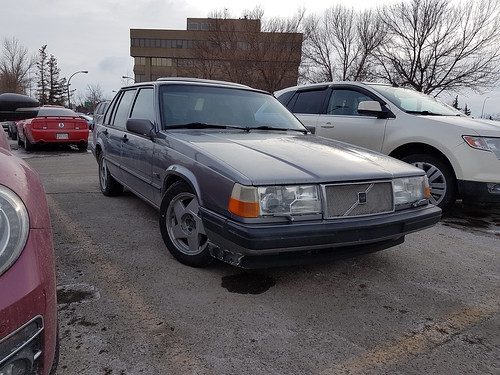Dearly Beloved, We Gather to Send Off the Volvo Estate
Volvo #Volvo

Volvo has announced it will no longer sell “estates” in the United Kingdom—another blow to the once ubiquitous station wagon.
Estates have “been fading out” in the UK and European markets, under the argument that a crossover has more space than a wagon.
How much time does the iconic Volvo wagon have left in the US? Given the V60 hybrid’s low volumes, you probably have two to three years at best.
Personal anecdote: Thirty years ago this reporter was living in a middle-class apartment in a large, postwar building in front of The River School, a tony, progressive pre-K through third-grade private institution in the Palisades neighborhood of Washington, DC.
While waiting for the metro bus to the Red Line weekday mornings, I watched Volvo wagon after Volvo wagon—mostly 940s and 740s—discharge young passengers onto the sidewalk in front of the school. Volvo was well past its image as the college professor’s car.
That section of Macarthur Boulevard is probably jammed with Teslas these days, but the iconic Volvo wagon endures, sort of. And not for any longer in the United Kingdom, where Volvo has announced it will stop selling “estates.”
While Volvo’s UK lineup is as tony as the premium models it sells in the US, the image of the brand’s estates is perhaps a bit more “gentleman farmer” rural than suburban or Ivy League parking lot.
“They stood for green wellies and Labradors,” former Top Gear co-star Richard Hammond told BBC Radio.
You might think the UK was more resistant to the charms of sport/utilities and hold out on Volvo wagons.
Our market flipped to majority-SUV and crossovers, leaving sedans and wagons languishing on dealers’ lots at least a decade ago. But just a few years after, both the European Union and the UK followed us into our weakness for tall H-points and driving positions.
Estates have “been fading out” in the UK and European markets, analyst Jim Hall says, under the argument “that a crossover has more space than a wagon.” It’s mostly a combination of image and function, he says.
The outgoing UK market Volvo estates are the V60 Recharge and V90 Recharge hybrids and mild hybrids.
Volvo V90 Recharge wagon.Volvo
Technically, Volvo USA continues to sell a real station wagon, even when classifying the V60 Cross Country and V90 Cross Country as crossovers. The hybrid-powered Volvo V60 Recharge remains available in the US through the 2024 model year, along with the two Cross Country models, a spokesman said.
The V60 truly is a station wagon in proportions and dimensions, just 56.6-inches tall with a midsize overall length of 187.4 inches, compared with the V60 XC’s 59.2-inch height and 188.3-inch overall length.
It’s hardly your parents’ Volvo 740 wagon, with a hybrid powertrain making 455 hp combined, yielding a 4.3-second (manufacturer’s estimate) 0-60 mph time, a 74 MPG-e EPA estimate, and a Polestar-tuned chassis.
Thanks to its sticker price, you’re more likely to see one dropping the kids off at Georgetown Day School than The River School: $72,345, a $21,500 premium over the quotidian V60 XC.
This is the sort of Volvo you will have to pre-order. None were listed online in a spot-check of dealers in the East, Great Lakes region, and West Coast.
How much time does the iconic Volvo wagon have left in the US? Volvo’s long-stated plan is to go all-EV by 2030. But given the V60 hybrid’s low volumes, you probably have two to three years at best.
Maybe Volvos weren’t in your driveway, but do you have any fond station wagon memories growing up? Like Eric Forman and his Olds Vista Cruiser? Please comment below.